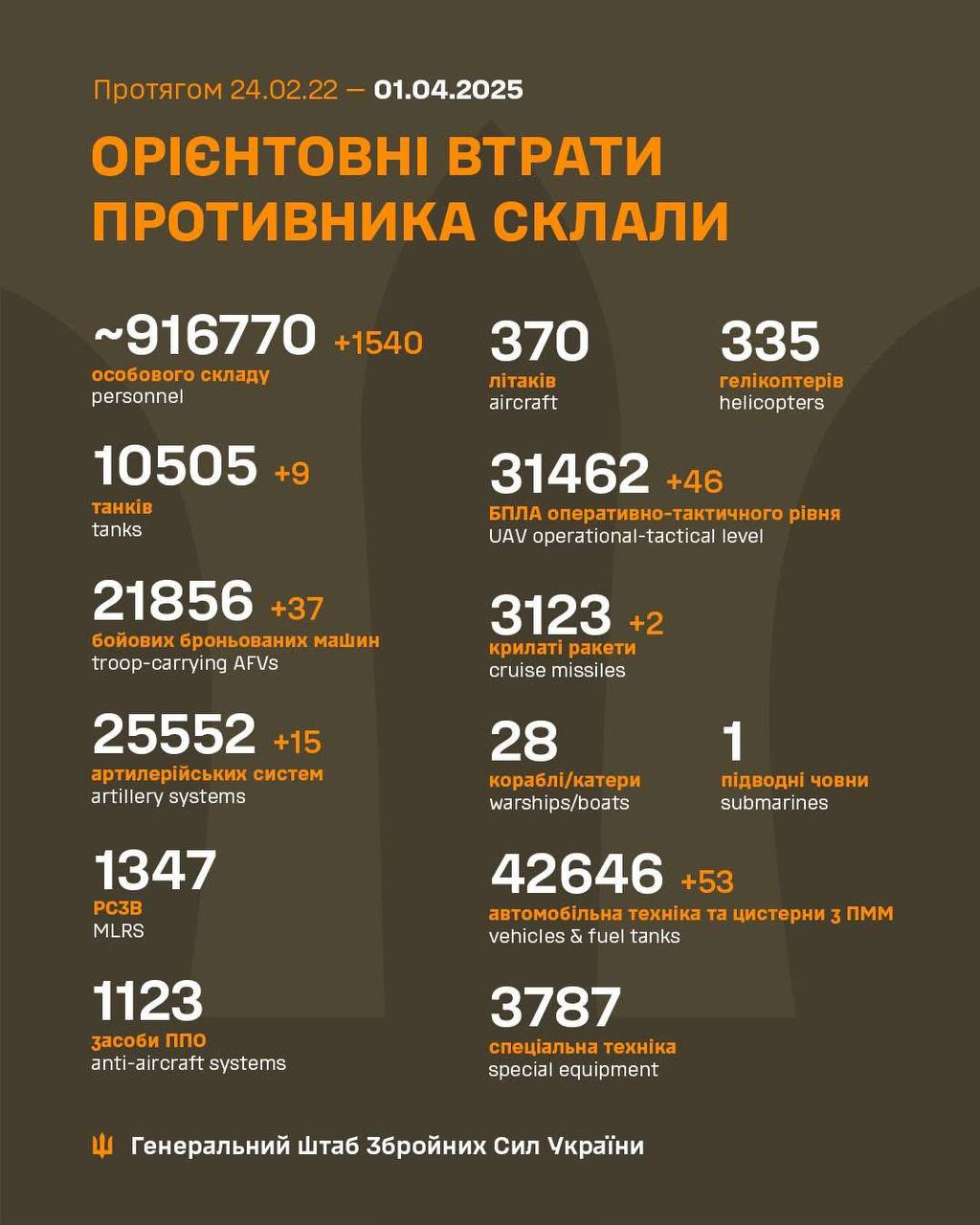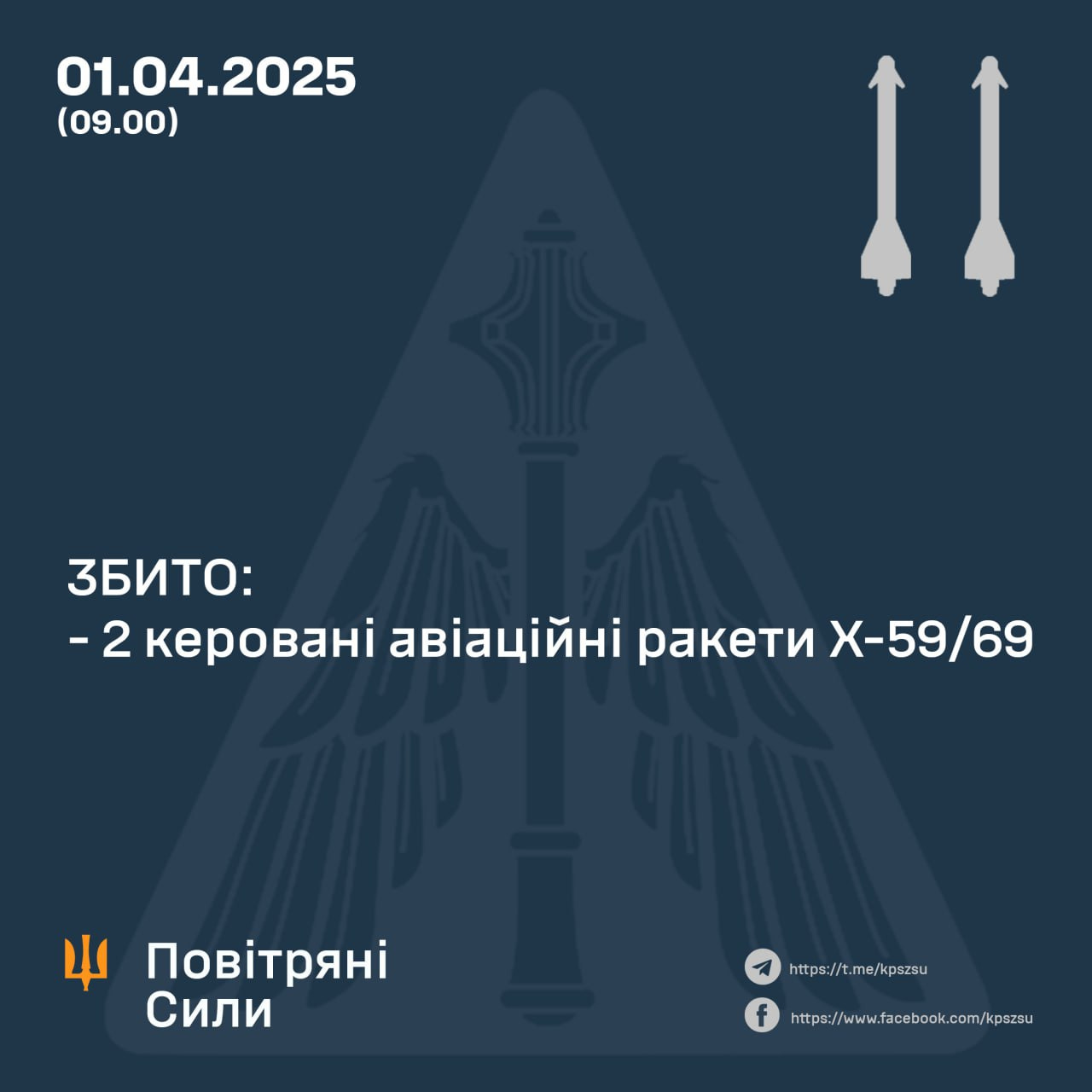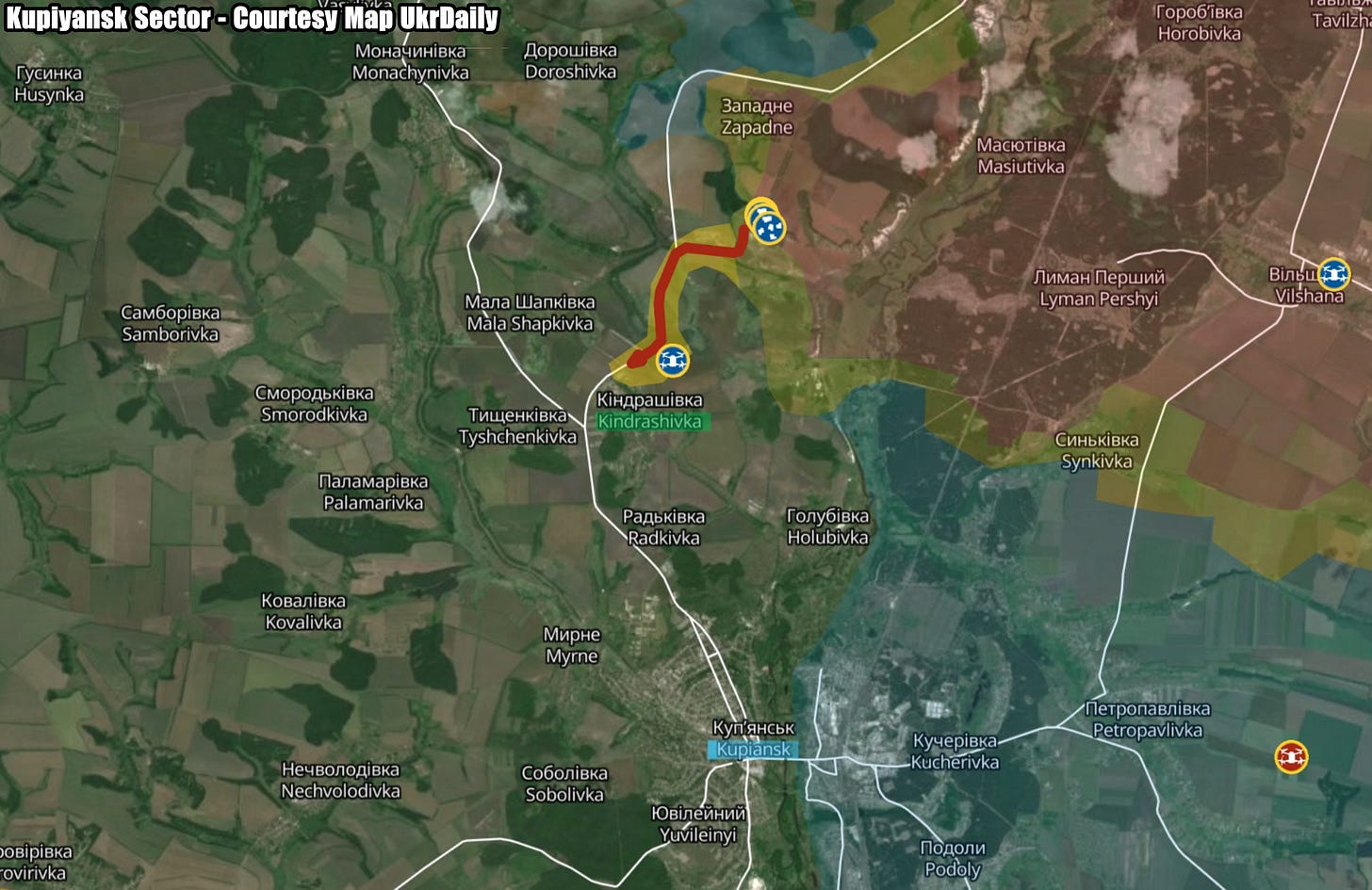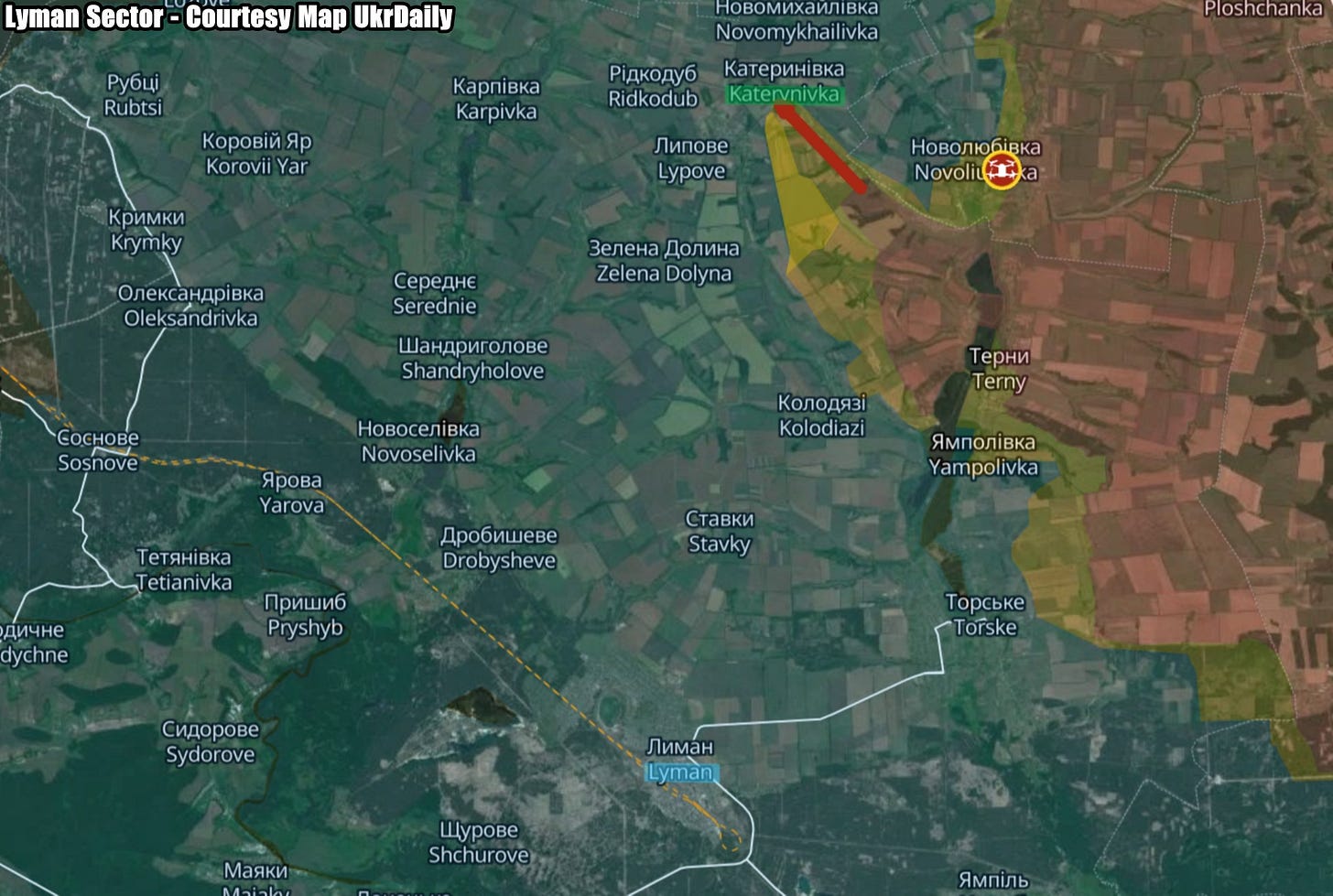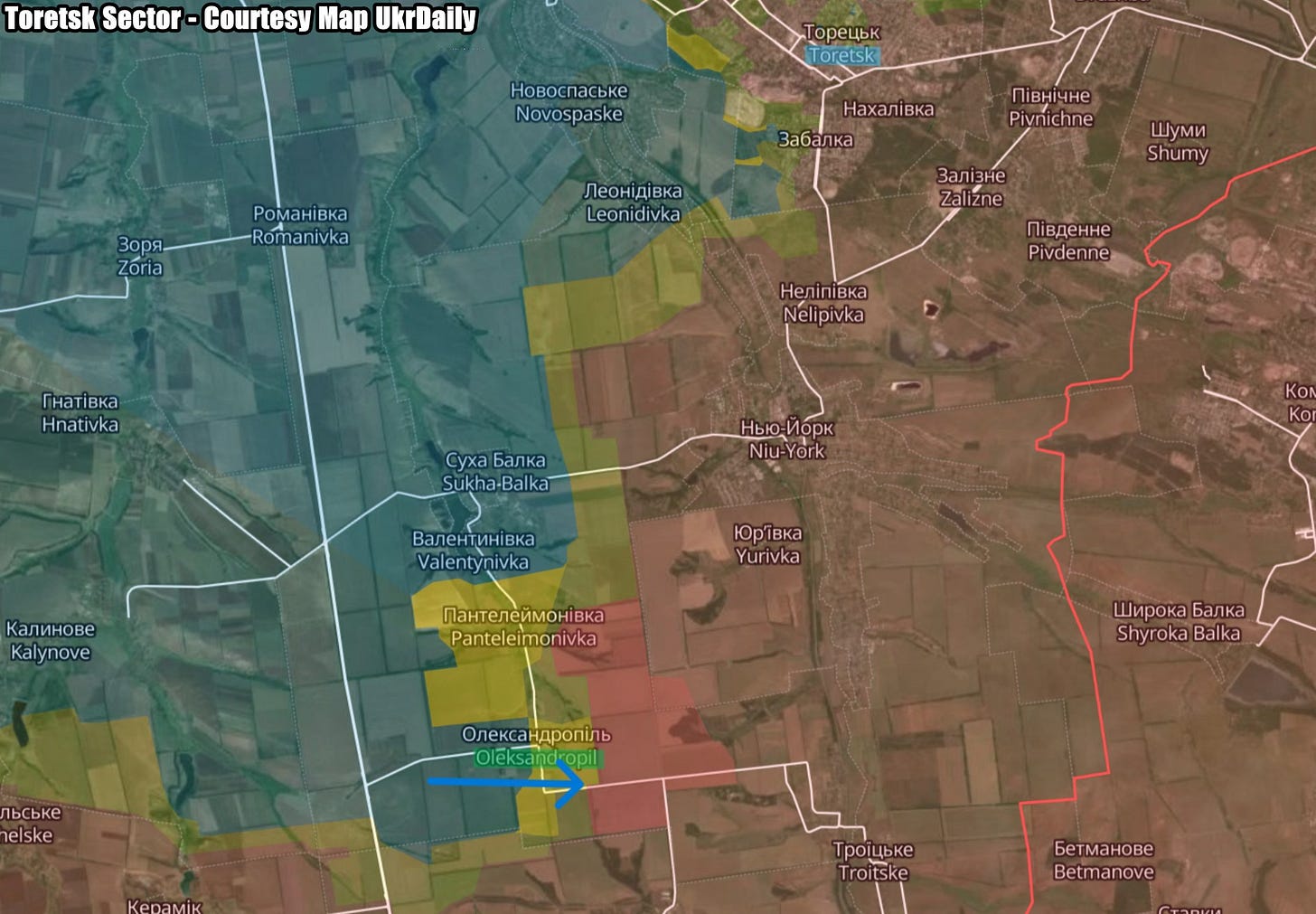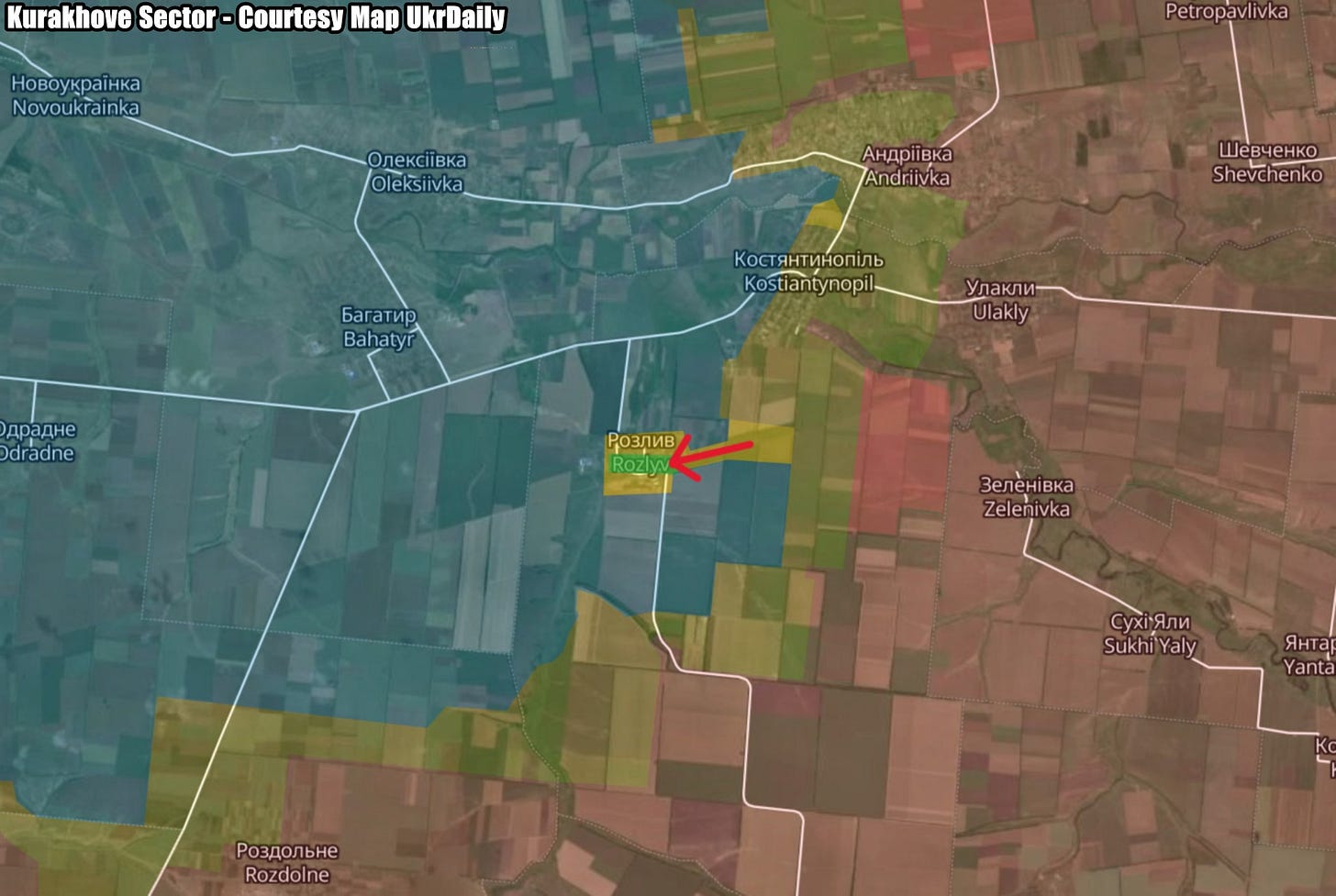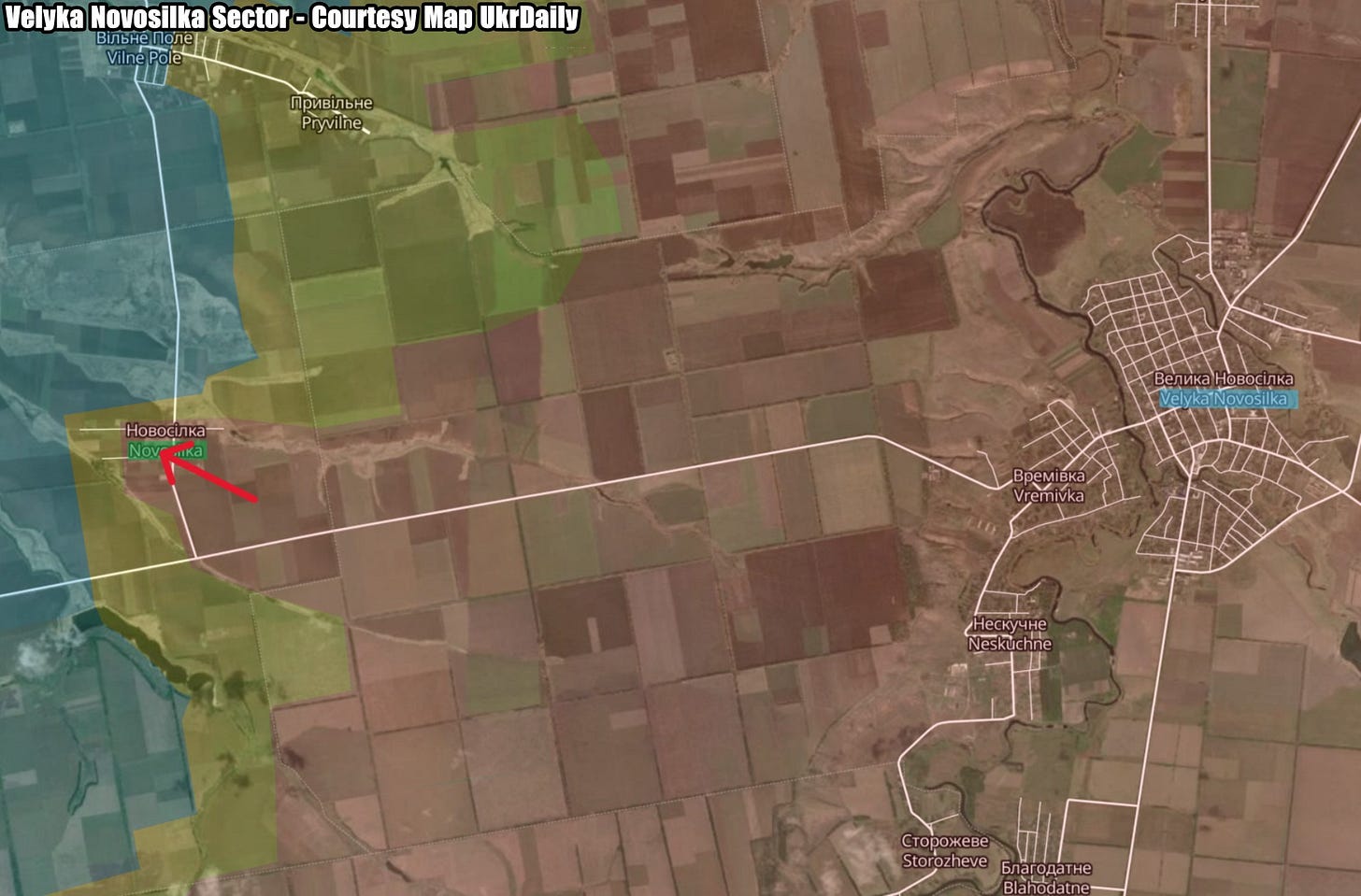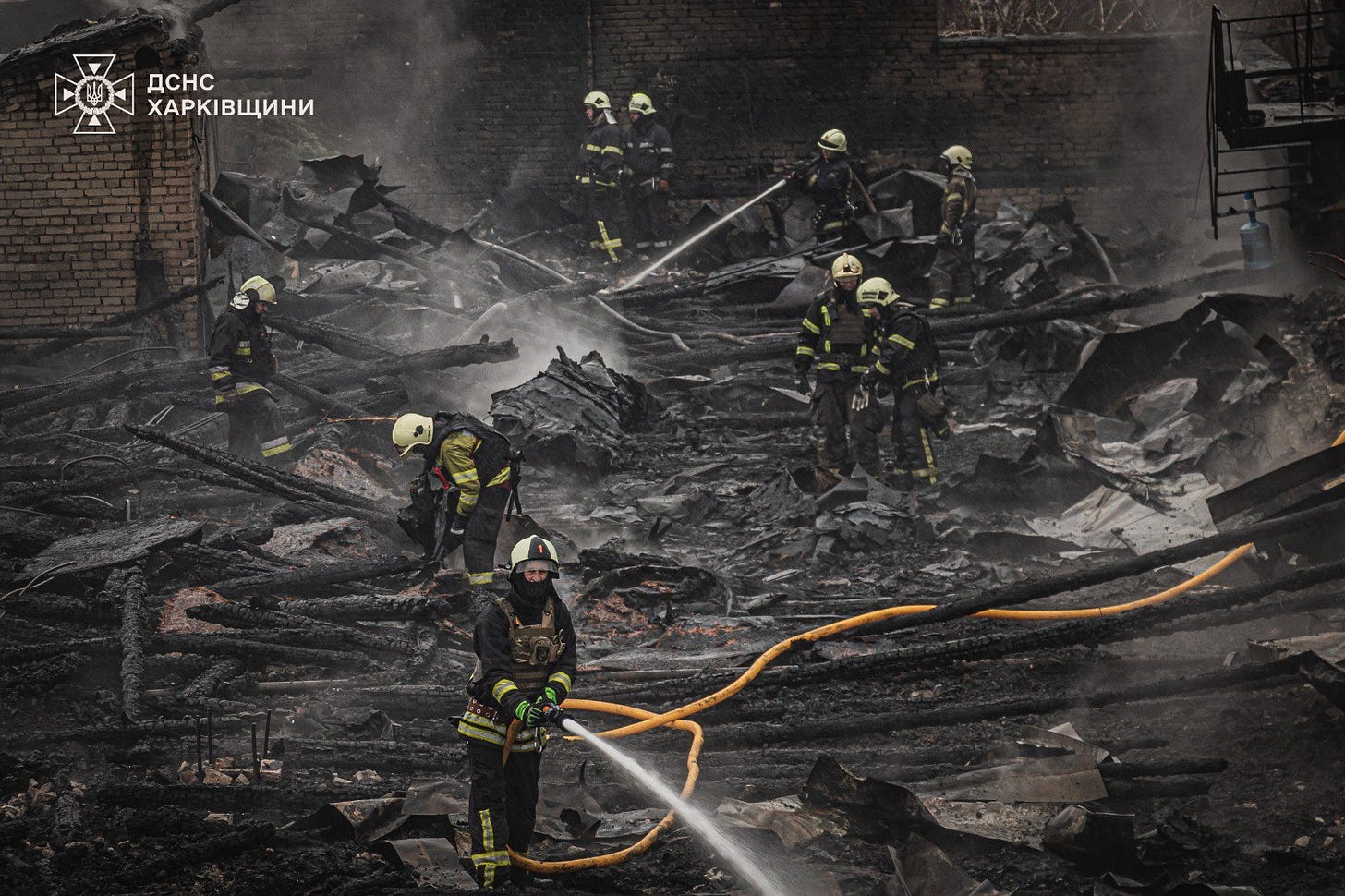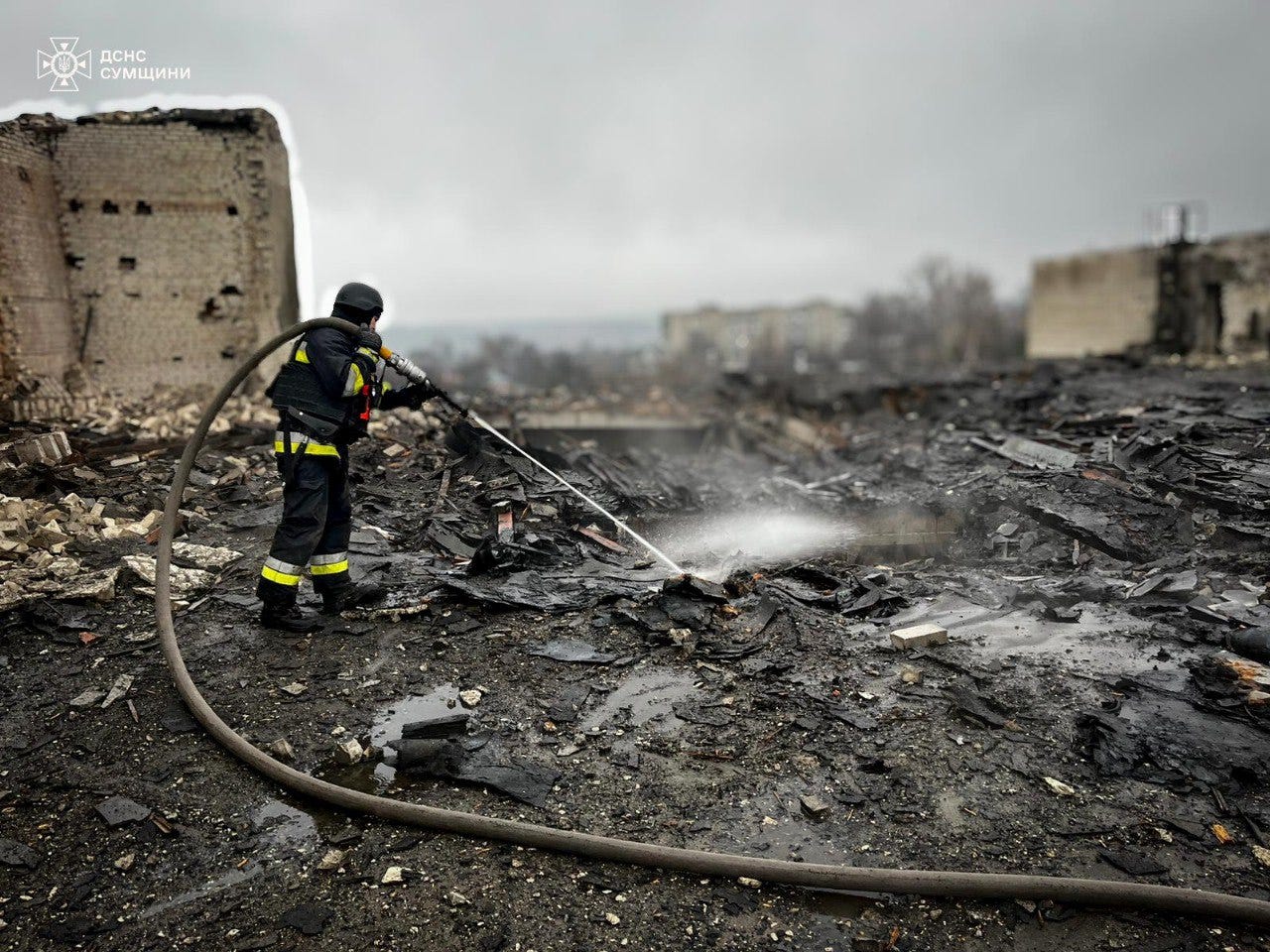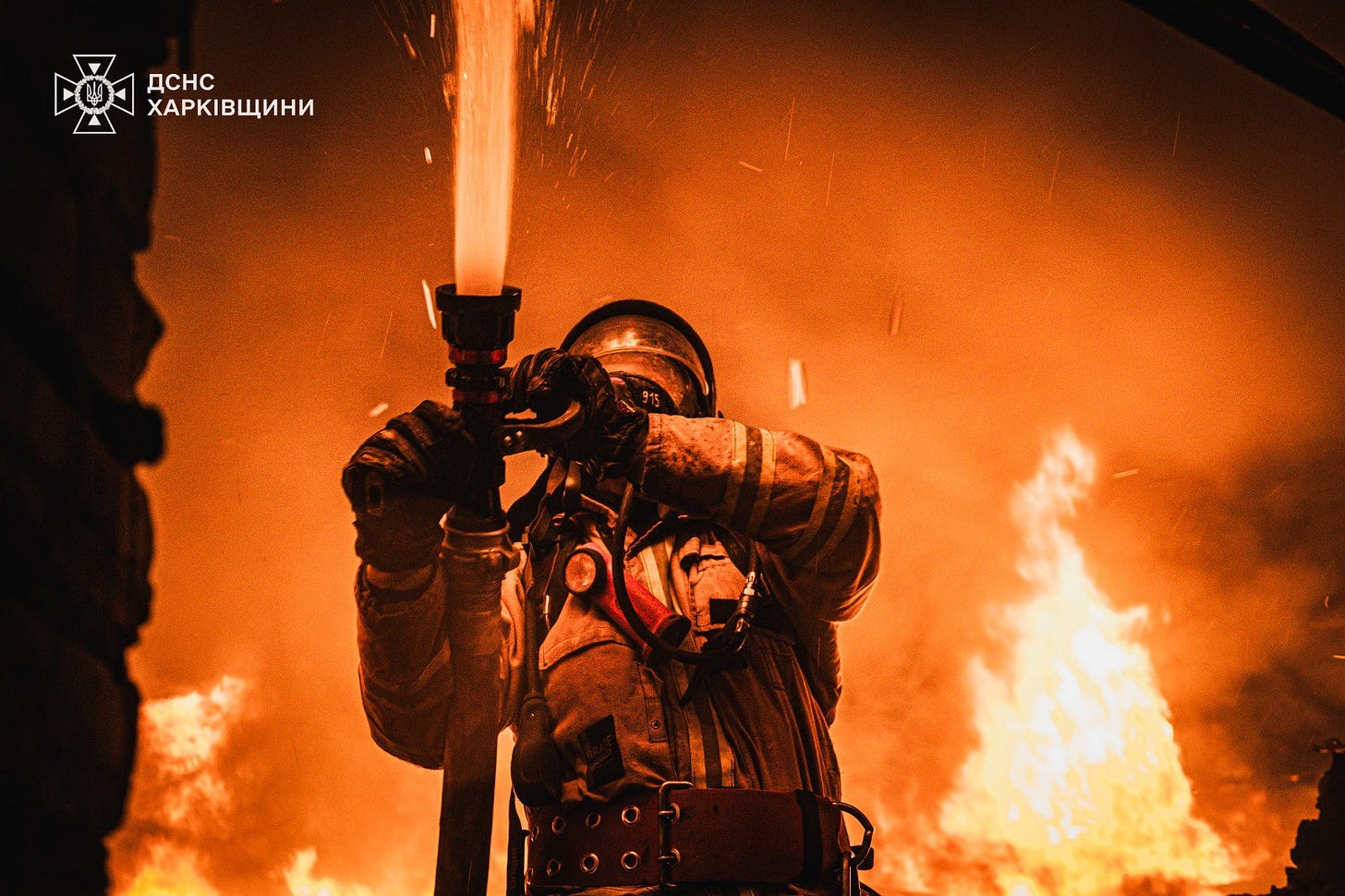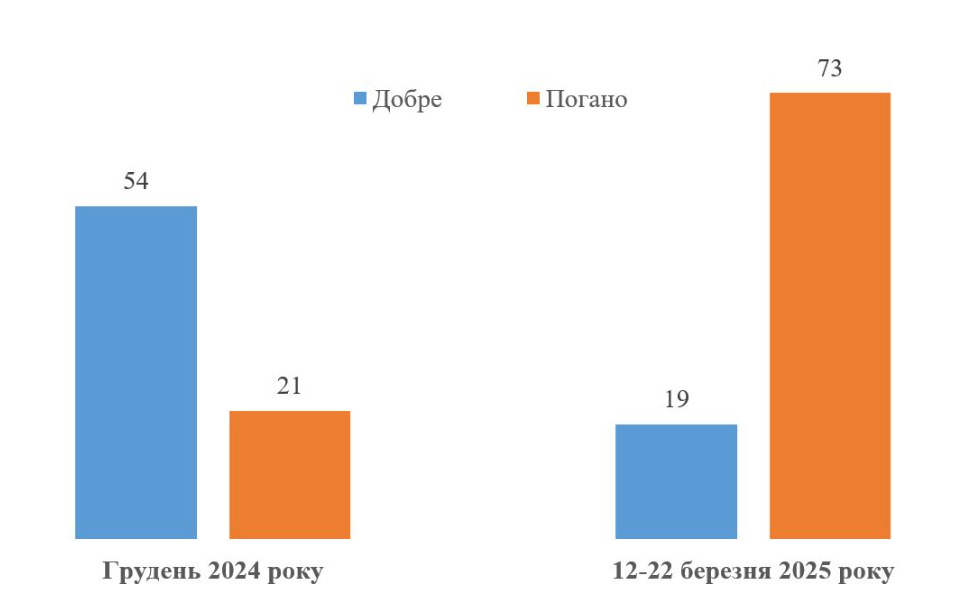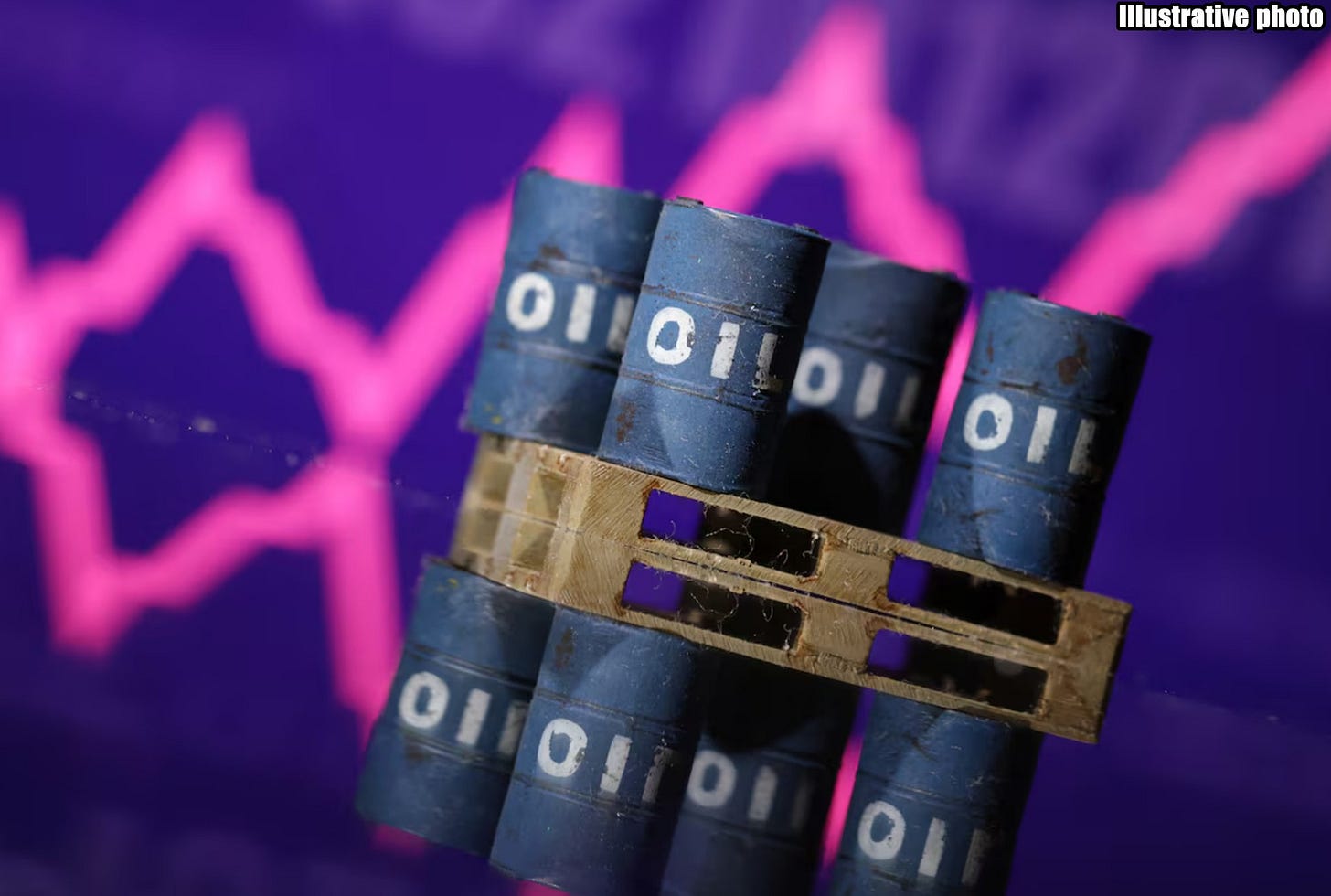Slava Ukraini! In early 2022 I began a Telegram channel aggregating news from a number of sources daily on the war in Ukraine. In June 2023 I began providing a daily draft for the Ukraine War Brief Podcast collecting news from over 70 sources daily, which formed the basis of the script. While the Podcast no longer exists I have continued to make this Brief available for my followers here on Substack for those who wish to keep up with the news from the war.
All the latest news on the Russo-Ukraine War 6 days per week
ALONG THE CONTACT LINE
GSAFU Morning Report
For: Apr 1
The General Staff of the Armed Forces of Ukraine in its Operational Information update at 08:00 on Apr 1 stated that day 1133 of the full-scale invasion of the Russian Federation against Ukraine had begun.
The situation on the line of combat remains tense in some sectors. Ukrainian defenders continue to actively counteract the Russian aggressor, causing them significant losses in personnel, equipment and technology. Exhausting the enemy along the entire front line and continuing to disrupt the plans of Russian occupiers to advance deeper into the territory of Ukraine.
During the past day, 216 combat engagements took place.
Over the past 24 hours, the enemy carried out 2 missile strikes, 99 air strikes, used 2,223 drones and fired approximately 5,200 artillery shells across the positions of Ukrainian forces and civilians.
Air Force Daily Report
TWO GUIDED AIRCRAFT MISSILES X-59/69 WERE SHOT DOWN
➖➖➖➖➖➖➖➖➖
On the night of Apr 1, 2025 (around 9:00 p.m. on Mar 31), the enemy struck with two Kh-59/69 guided aircraft missiles from tactical aircraft in the Zaporizhia direction.
Both missiles were shot down by air defenses.
Combat Operations in the Russian Federation
The Institute for the Study of War (ISW), a US based think tank, in its Mar 31 Russian Offensive Campaign Assessment reported that:
Kursk Salient: Russian forces recently advanced along the Sumy-Kursk Oblast border amid continued Russian efforts to push Ukrainian forces from Kursk Oblast.
Geolocated footage published on Mar 28 indicates that Russian forces recently seized Veselivka, Sumy Oblast (north of Sumy City). The Russian Ministry of Defense (MoD) published footage on Mar 31, which ISW geolocated, indicating that elements of the Russian 137th Airborne (VDV) Regiment (106th VDV Division) advanced in central Gogolevka, Kursk Oblast (southwest of Sudzha).
Belgorod Incursion: Russian forces continued assaults in northwestern Belgorod Oblast on March 31 but did not make any confirmed advances.
Russian milbloggers claimed on March 31 that fighting continues near Demidovka and Popovka (west of Demidovka).
The Khortytsia operational-strategic group
(Responsible for the northeastern part of Ukraine. )
Kupyansk Sector: Russian forces recently advanced in the Kupyansk direction.
Assessed Russian advances: Geolocated footage published on Mar 30 and 31 indicates that Russian forces recently advanced along the P-79 Kupyansk-Dvorichna highway and in fields northeast of Kindrashivka (north of Kupyansk).
Lyman Sector: Russian armed forces recently advanced in the Lyman direction.
Mashovets stated that Russian forces advanced to the southern outskirts of Katerynivka (northeast of Lyman).
Toretsk Sector: Ukrainian forces recently marginally advanced in the Toretsk direction.
Geolocated footage published on Mar 30 indicates that Ukrainian forces recently marginally advanced in southern Oleksandropil (southwest of Toretsk).
The Tavria operational-strategic group
(Responsible for the central-eastern and southeastern part of Ukraine.)
Kurakhove Sector: Russian forces recently advanced in the Kurakhove direction.
Geolocated footage published on Mar 29 indicates that Russian forces recently advanced to eastern Rozlyv (southwest of Kurakhove).
Velyka Novosilka Sector: Russian forces recently advanced in the Velyka Novosilka direction.
Assessed Russian advances: Geolocated footage published on Mar 30 indicates that Russian forces recently advanced in central Novosilka (west of Velyka Novosilka).
The Odesa operational-strategic group
(Responsible for Kherson, Qırım, (also known as Crimea) and the Black Sea.)
There have been no major changes to the combat environment since our last report.
TEMPORARILY OCCUPIED TERRITORIES
Nothing major to report.
THE HOME FRONT
2 killed, 21 injured in Russian attacks against Ukraine over past day.
Russian attacks across Ukraine killed at least two civilians and injured at least 21 over the past day,the Kyiv Independent reported citing regional authorities on Apr 1.
Ukrainian air defenses shot down two Kh-59/69 guided aerial missiles launched by Russia against Zaporizhzhia Oblast, the Air Force repored. Russian forces did not carry out a mass drone strike against Ukrainian civilian infrastructure overnight, marking first such instance in 2025.
Russian forces attacked the Nikopol district in Dnipropetrovsk Oblast overnight and on Mar 31, Governor Serhii Lysak reported. A 54-year-old man and a 46-year-old woman were injured.
In Dontesk Oblast, Russian attacks killed one civilian in the village of Bahatyr and injured one in the village of Drobysheve, Governor Vadym Filashkin said.
Five people were injured in Kupiansk in Kharkiv Oblast as a result of Russian attacks, and five houses, two cars, and a garage were damaged, Governor Oleh Syniehubov reported.
This included a 59-year-old man and two women aged 74 and 53 injured in an aerial bombing of the town, and a 63-year-old man and a 35-year-old woman injured in artillery shelling.
Six people were injured in Russian attacks against Kherson Oblast, said the regional governor, Oleksandr Prokudin. Four high-rise buildings and 11 houses were damaged.
Russian strikes on Sumy Oblast injured two civilians, damaged several houses, and started a fire at a cultural center, the regional military administration reported.
In Zaporizhzhia Oblast, one woman was killed and five people were injured in a Russian attack against the village of Malokaterynivka, Governor Ivan Fedorov said.
Russia again violates partial ceasefire by attacking Kherson energy facility.
Some 45,000 residents of Kherson were left without electricity after a morning Russian attack on one of the city's power facilities, Foreign Minister Andrii Sybiha said on Apr 1 during a joint press conference with his Lithuanian counterpart Kestusis Budrys, the Kyiv Independent reports.
The attack happened after Russia and Ukraine announced a partial ceasefire on strikes against energy facilities following technical consultations with the U.S. in Riyadh the previous week.
"After Riyadh, one of the agreements with the U.S. was about not striking at energy infrastructure," Sybiha said at the press conference.
"At the same time, Russia continues to violate this agreement," the minister said, adding that Ukraine has also recorded attacks against energy facilities in the Kherson, Kharkiv, and Poltava oblasts since March 25.
According to the local military administration, the Central and Korabelnyi districts of Kherson are without electricity. Electric transport is partially out of service due to the outages.
Throughout the full-scale war, Russia has consistently used targeted missile and drone strikes to knock out Ukraine's power grid, while Kyiv has hit oil and gas facilities inside Russian territory with long-range drones.
Ukraine and the U.S. previously agreed on a full 30-day truce during their talks in Jeddah on March 11. Russia had rejected this proposal unless it included conditions undermining Kyiv's ability to defend itself, such as a full halt on foreign military aid.
Moscow has claimed that its side of the energy ceasefire has been in effect since Mar 18, when Russian President Vladimir Putin allegedly declared a halt on such attacks following a call with U.S. President Donald Trump.
In spite of this, Russian forces also reportedly attacked Kherson's energy infrastructure on Mar 27, violating the terms of the U.S.-brokered limited ceasefire.
73% of Ukrainians say Trump is bad for Ukraine, poll shows.
Around 73% of Ukrainians believe that U.S. President Donald Trump is bad for Ukraine, a major spike from December 2024, when only 21% saw him negatively, a survey by the Kyiv International Institute of Sociology (KIIS) published on April 1 said.
Last December, after Trump was reelected but before he took office, 54% of Ukrainians believed that the new U.S. president would have a positive impact on Ukraine. Only 19% thought so in March, KIIS said.
The Trump administration has brought a major shift to Washington's policy on Ukraine.
Pledging to broker a swift peace deal, Trump has sought to renew ties with Russia while repeatedly praising his relationship with Russian President Vladimir Putin.
The U.S. president has also strong-armed Ukraine into ceasefire negotiations by temporarily cutting off military and intelligence support early in March before publicly berating President Volodymyr Zelensky in the Oval Office on Feb. 28.
Between March 12 and 22, 55% of Ukrainians said they expect a rather or completely unjust peace deal from Trump, a minor drop from 58% between Feb. 14 and March 4 but a significant increase from 31% in December.
In turn, 23% of Ukrainians believed that Trump would bring a just peace in December 2024, 11% between Feb. 14 and March 4, and 18% between March 12 and 22.
RUSSIAN WORLD
Russian Railways hit by major cyberattack.
The Russian Railways company was hit by a large-scale cyberattack on April 1, the company said, as the website and app became inaccessible, the Kyiv Independent reports.
The state-owned Russian railway operator described the incident as a "massive DDoS (distributed denial-of-service) attack," saying that efforts to restore operations are underway.
The news follows a cyberattack against Ukrainian Railways (Ukrzaliznytsia) on March 23, which also rendered its website and app inaccessible and prevented online ticket purchases for days.
Ukraine said that the attack against Ukrainian Railways resembled the tactics of Russian intelligence services.
Downdetector.su, a website monitoring website crashes, recorded a spike of complaints about Russian Railways' website at 11:45 a.m. local time, with 489 users reporting problems at the time. The website remains inaccessible as of 2:15 p.m.
It remains unclear who was behind the cyberattack. Russian Railways said their ticket offices at train stations are operating as usual.
The disruption came only a day after the Moscow Metro app became inaccessible, with its website displaying Ukrainian Railways' statement about its technical failure.
RELATED INTERNATIONAL NEWS
Trump's Russian oil tariff threat doesn't faze traders who suspect it's a bluff.
U.S. President Donald Trump's threat to hit buyers of Russian oil with tariffs had a limited impact on oil markets on Monday, as traders tried to determine how far the White House could go after Chinese and Indian oil importers, Reuters reported on Mar 31.
Trump's proposal to hit buyers with a 25% to 50% tariff would be significant for oil markets if it turned into an order, but analysts and traders questioned whether the threat was just Trump showing one of many cards in his talks with Russia.
"He changes his mind, so the market is struggling to keep up," said Adi Imsirovic, an energy consultant and former oil trader. "The market does not believe it any more until it is firm and a few weeks old."
Oil made modest gains on Monday, with global benchmark Brent crude rising by 1.4% to above $74 a barrel. In early March, it fell to almost $68, the lowest since December 2021.
"As Trump yoyos in his decision-making, so do oil prices," said David Goldman of brokerage Novion. "In the bigger picture, the correction from the selloff appears to have stalled, and the price is moving sideways."
China and India are the major buyers of Russian crude, and their reaction would be crucial to making any secondary sanctions package seriously hurt the world's second-largest oil exporter.
In the aftermath of Russia's invasion of Ukraine in 2022, India surpassed China to become the biggest buyer of seaborne Russian crude.
Russian oil comprised about 35% of India's total crude imports in 2024, raising the stakes for what has become a crucial outlet for Moscow if Trump exerts pressure on New Delhi.
In February, India's oil secretary said the country's refiners would buy Russian oil supplied by companies and ships not sanctioned by the U.S., effectively reducing the number of cargoes and vessels available.
Meanwhile Chinese state oil companies have shied away from Russian oil, with Sinopec (600028.SS), opens new tab and Zhenhua Oil halting purchases, while two others scaled back volumes in the face of renewed U.S. sanctions, Reuters has reported.
China's top importers of Russian oil are independent refiners with limited ties to the U.S. financial system, which makes them more resilient to pressure and sanctions from Washington.
"There's an element of fatigue with the announcements from the U.S. administration on tariffs and sanctions," said ING's head of commodities strategy Warren Patterson.
"So I suspect until we get something more concrete, the market is not going to overreact to this," he said.
In India, a refinery official said the threat added uncertainty to the purchasing plans for Indian refiners and was creating difficulties for crude buyers.
However, on Monday morning several Chinese traders were unfazed by the latest threat. Three who spoke with Reuters all said Trump's constant brinksmanship meant they discounted what he said.
“We're all numb now, oil prices are not responding,” said one trader who spoke on condition of anonymity. "It's no use listening to Trump anymore."
"It’s hard to tell what the impact would be as Trump is always bluffing, his words have lost credibility," said a second.
EU supports automatic liability for Russia’s war crimes against Ukraine.
EU High Representative Kaja Kallas has stated the need for automatic responsibility for the crimes of the Russian leadership and war crimes against Ukrainians, emphasizing the importance of justice and support for Ukraine, Interfax-Ukraine reports.
She said this on Tuesday in Strasbourg during a plenary session of the European Parliament,"It is clear that responsibility for crimes of aggression, that is, crimes of leadership, when someone decides to attack another country, as well as war crimes, should be more automatic," Kallas said.
Kallas emphasized that one of the main challenges is the impunity that used to be possible. Thanks to modern technology, such as photographs, phone records, and radio transcripts, it is now impossible to deny that crimes have been committed. She emphasized the importance of collecting evidence, including documented cases of forced displacement and deportation of Ukrainian children, which are among the most serious human rights violations.
"The number of crimes committed in this war is simply unsurpassed," she emphasized.
The EU High Representative also said that the birth rate in Ukraine has dropped by 30% as a result of the war, emphasizing how devastating the war is for the country's future. She also mentioned the EU sanctions against more than 70 people responsible for the deportation of children from Ukraine.
"Russia's campaign against human life and dignity truly has no limits. We also see this in reports of enforced disappearances, torture, extrajudicial executions, sexual violence against civilian prisoners and prisoners of war by Russian armed forces in the occupied territories," said Kallas.
Kallas also reiterated the EU's support for the establishment of a special tribunal to investigate the crime of Russian aggression and its support for Ukraine in its quest for justice. She noted that the EU is actively assisting in the investigation of more than 117,000 criminal cases in Ukraine.
"That is why the EU also supports the Prosecutor General's Office of Ukraine by strengthening its capacity to investigate and prosecute international crimes committed in Ukraine, including through the EU Civilian Advisory Mission. And with regard to the specific crime of aggression, the EU is working to establish a special tribunal," Kallas said.
MILITARY & TECH
Sweden to Supply Ukraine with Weapons in a $1.6 Billion Aid Package.
Sweden announced the provision to Ukraine with the largest aid package, which, in addition to armored vehicles and air defense systems, includes equipment and machinery for an airbase, Defense Express reports.
The Defense Forces of Ukraine can count on new weapons reinforcement from Sweden. The Swedish government has announced another aid package worth about $1.6 billion (SEK 16 billion). This aid package is the 19th since 2022 and the largest ever.
In total, Stockholm has provided assistance worth around $8 billion, meaning this package accounts for 20% of all funds. Moreover, in order to provide it, it was necessary to revise budget documents and transfer some money from the planned aid for 2026.
The official report also outlines the distribution of these funds for needs identified jointly with Ukraine and other partners. In particular, $0.92 billion will be spent on ammunition, air defense systems, armored vehicles, marine equipment, satellite communications systems, and infantry equipment. When selecting a supplier for these new weapons, priority will be given to short deliveries and to the Swedish, Scandinavian and European defense industries.
In light of this, it is likely that the contract for ammunition production will be awarded to the Scandinavian Nammo company. Air defense systems may include Saab products such as the RBS 70 MANPADS and/or Giraffe radar, while armored vehicles may include additional CV90 infantry fighting vehicles from BAE Systems Hägglunds.
Another $0.5 billion will be distributed among various international assistance programs for Ukraine, as well as orders for Ukrainian weapons under the so-called Danish model.
The list of weapons to be transferred by Sweden from its own stockpiles, worth $50 million, includes about 100 units of various types of airbase servicing equipment, as well as equipment for operating the base.
This may be a hint of a possible transfer of Gripen fighters. Moreover, Sweden has already reserved spare parts for 14 Gripen C/Ds in Ukraine's interest and plans to retire these fighters. The second option is the Saab 340 AEW&C (ACS890) airborne early warning and control aircraft, announced for transfer but not yet delivered. It should be noted that Sweden announced the transfer of two such aircraft on May 29, 2024, but they have reportedly not arrived in Ukraine since then. [this delivery was linked to upgrades to Ukraine’s fleet of F-16s that have reportedly now taken place]
In addition, the package includes FN MAG machine guns, training equipment with Carl Gustaf grenade launchers, medical service vehicles, medical equipment, small-caliber ammunition, personal equipment, etc.
Other funds are allocated to financing support for already transferred weapons, civil defense, guaranteeing payment for Ukrainian purchases on credit from Swedish defense companies, support for security research, and more.
Details emerge on the new RAM-2X UAV
The RAM-2X Features a Ukrainian EFP Warhead That Leaves Russian Troops with Little Chance of Survival and Operates in Tandem with the Shark UAV, Defense Express reports.
Photos of a crashed RAM-2X emerge, revealing the type and weight of its warhead, which turns out to be quite unusual, and showing how the RAM-2X and Shark form a deadly duo.
Russians have published photos of the new Ukrainian fixed-wing loitering munition, the RAM-2X, which crashed in the occupied part of Donetsk Oblast. It is an advanced version of the RAM II loitering munition. The crash was likely caused either by a technical malfunction or a loss of communication due to enemy electronic warfare systems.
Inside the RAM-2X, the published photos show a marking labeled "controlled charge," indicating that the detonation occurs at a specific distance from the target either automatically or by operator command. Another notable detail on the warhead is the marking "01-24," which signifies its production date—either January 2024 or the first quarter of 2024.
Additionally, the marking "ЗК 2,7 УЯ" can be seen, which can likely be deciphered as follows: "ЗК" stands for "controlled charge," "2,7" indicates its weight, meaning 2.7 kg. As for "УЯ," the most probable explanation is that it refers to its effect type—an explosively formed penetrator (EFP).
An explosively formed penetrator operates on a similar principle to a shaped charge. However, while a shaped charge relies on a high-velocity jet, an EFP is a solid projectile formed by the detonation of a "shaped" liner, which accelerates to speeds of up to 5 km/s. An EFP allows for effective engagement of targets at a considerable distance, meaning that welded grids and armor screens on vehicles provide little protection against it. The presence of such a warhead on this drone indicates that its production has been established in Ukraine.
A photograph also captured the moment when the RAM-2X was being disarmed by a ground robotic platform equipped with a manipulator and an X-ray scanner for inspecting the drone’s body. Typically, fallen kamikaze drones are simply destroyed since disarming them is usually pointless. However, this time, the Russians even brought in a specialized robot for disarming it, likely to study it in detail afterward.
The RAM-2X features X-shaped aerodynamic surfaces, which, compared to conventional configurations, increase its maneuverability and allow it to remain airborne at significantly lower speeds. Its exact specifications have not been disclosed, but some sources mention a range of 120 km and a maximum speed of 160 km/h.
The RAM-2X features X-shaped aerodynamic surfaces, which, compared to conventional configurations, increase its maneuverability and allow it to remain airborne at significantly lower speeds. Its exact specifications have not been disclosed, but some sources mention a range of 120 km and a maximum speed of 160 km/h.
It is worth noting that the warhead of the fallen RAM-2X was manufactured before the drone was first publicly demonstrated. This could indicate that either the same warhead is used in other UAVs, leading to stockpiling, or that the serial production and deployment of the RAM-2X began long before its first public appearance.
Overall, the emergence of these photographs may indicate an increase in RAM-2X production and further confirms the existence of domestic warhead manufacturing for drones of this class in Ukraine.
That’s it for today’s Brief folks if you would like to keep up with events in Ukraine daily please consider subscribing, it’s free!







